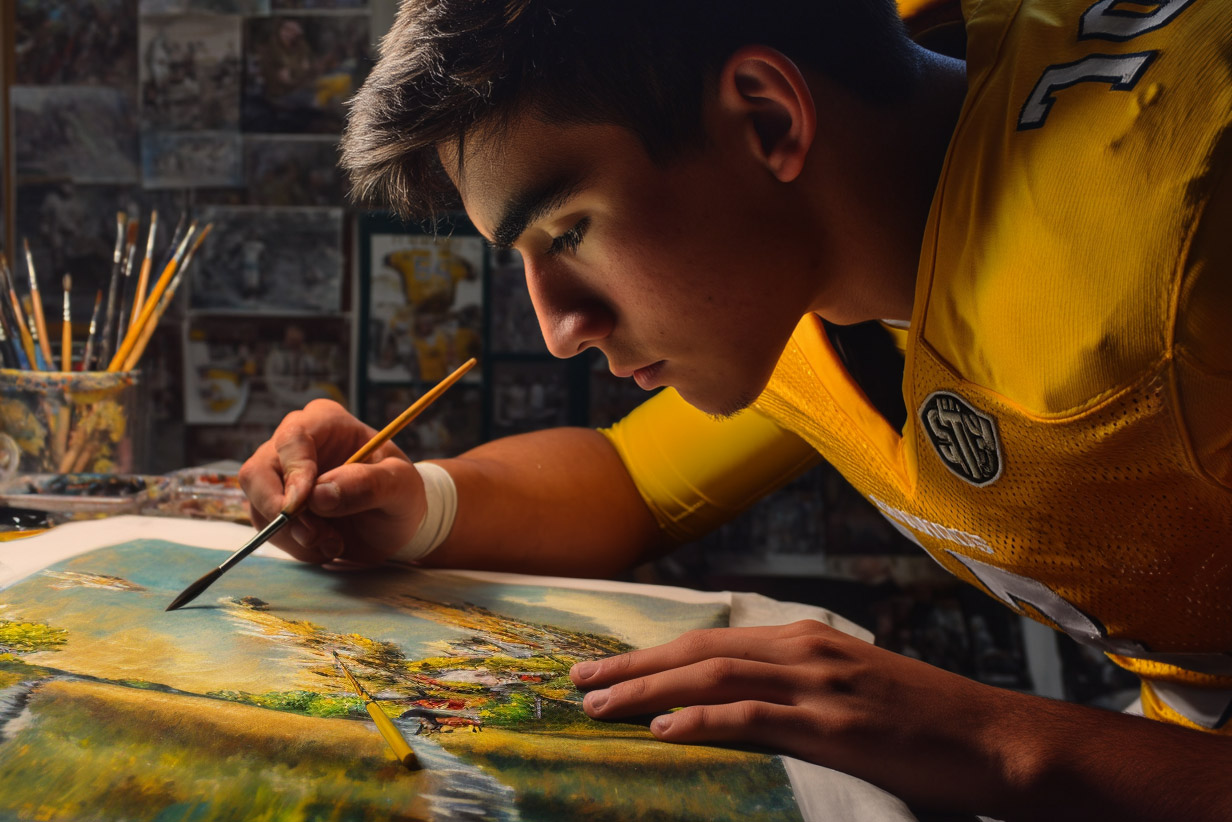Jose Portilla’s story is one of grit, balance, and reinvention. Born in Mexico and raised in Texas, he became the first Mexican-born NFL player to play in a Super Bowl, lining up in Super Bowl XXXIII with the Atlanta Falcons. But his path didn’t end with football. After earning a degree in visual communications from the University of Arizona, Portilla built a career as a professional artist and educator, now teaching at Heritage Academy in Mesa, Arizona.
In the classroom and on the field, Portilla models the power of pursuing passions with discipline. He has led high school teams to state championships, earned a Coach of the Year title, and inspired students in both art and athletics. To him, art is not an extracurricular—it’s essential to developing well-rounded students.
Balancing the Physical and the Creative
Portilla discovered early that art and athletics could complement each other. He began as an artist before picking up football in his junior year of high school. Initially underdeveloped in skill and strength, he overheard a coach say he’d “never amount to anything.” That doubt became fuel. He trained relentlessly, determined to surpass expectations.
While football demanded physical and mental preparation, art provided calm and a different kind of challenge. Portilla says many NFL players are artists, musicians, or sculptors. Creativity offers a balance to the physical grind, fostering vulnerability and a new way of thinking.
From Canvas to Career
Portilla’s work focuses on wildlife and landscapes, inspired by time spent outdoors with his father and grandfather. Whether capturing the glow of a sunset or the detail of an animal in motion, he seeks to preserve moments in time. His painting “Final Run,” depicting a sockeye salmon’s last upstream journey, earned fourth place in an international competition with over 11,000 entries. He even developed his own pastel paper to achieve the texture he needed.
While art once seemed a risky career choice, Portilla believes opportunities for creative professionals are growing. He points to industries like digital media, fashion, architecture, and AI design, where artists can command high salaries. Creativity, he argues, will be as valued in the future as medicine, law, and engineering.
Building a Strong Foundation in Art Education
At Heritage Academy, Portilla works to ensure students have solid drawing skills before advancing to more complex projects. Drawing, he says, is the foundation—like repairing dents before painting a car. Without it, students will struggle with any medium.
The program exposes students to multiple techniques and materials—pencil, ink, watercolor, acrylics, clay, printing—so they can discover what resonates most. While some students arrive with years of experience, others start with stick figures. Portilla grades individually, focusing on personal progress rather than peer comparison.
Impact Beyond the Classroom
For some students, art is a lifeline. Many say they wouldn’t attend school if it weren’t for art class. It provides an outlet for those not drawn to academics or sports, giving them a voice and a sense of belonging. Portilla recalls assignments that became powerful emotional expressions, like during COVID-19 when students created masked self-portraits revealing personal experiences inside the mask design.
Competitions and exhibitions also play a big role. Portilla guides students in building portfolios that speak louder than grades, preparing them for scholarship opportunities. He knows the value of this firsthand—his own high school art teachers drove him to competitions across Texas, shaping his career.
Learning Persistence and Self-Belief
One of Portilla’s core lessons is the 80/20 rule: success in art is 80% hard work, 20% talent. Time invested matters most. Each student’s portfolio becomes a visual record of progress—page after page showing improvement. This process builds confidence, especially for those hesitant to share their work.
Even students who don’t pursue art professionally benefit. Portilla believes the skills developed—patience, problem-solving, creative thinking—translate into any field. For him, art is a lifelong pursuit, one you can carry into old age when other activities may no longer be possible.
The Courage to Create
Portilla draws inspiration from the Impressionists—Van Gogh, Monet, Degas—who broke from perfectionism to capture light, air, and emotion. They faced rejection from traditional institutions but won the people’s admiration. Their courage to defy norms reshaped the art world, influencing everything from design to technology.
He urges students to find their own artistic fingerprint, learning from others while developing a unique style. Being a professional artist today also means being business-savvy—marketing work, managing finances, and staying visible online.
Art as an Essential Investment
Portilla worries that cutting arts programs shortchanges students. While budgets are often tight, he notes that art supplies are more affordable than many assume. The return—personal development, emotional expression, and creative problem-solving—is immense. He sees a renewed interest in the arts, and schools like Heritage Academy are leading the way by balancing sports, academics, and creative programs.
In the end, Portilla’s journey comes back to resilience. Whether fighting for a roster spot in the NFL or layering pastels on a custom paper, he embraces challenge. He teaches his students to do the same—working steadily, improving with each effort, and using creativity to navigate life’s toughest plays.
For him, the signature on a final piece is more than ink—it’s the mark of a life spent creating, a testament to the belief that art and grit together can shape both a career and a character.
